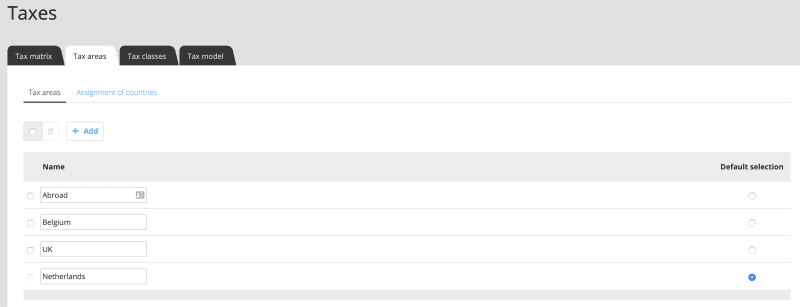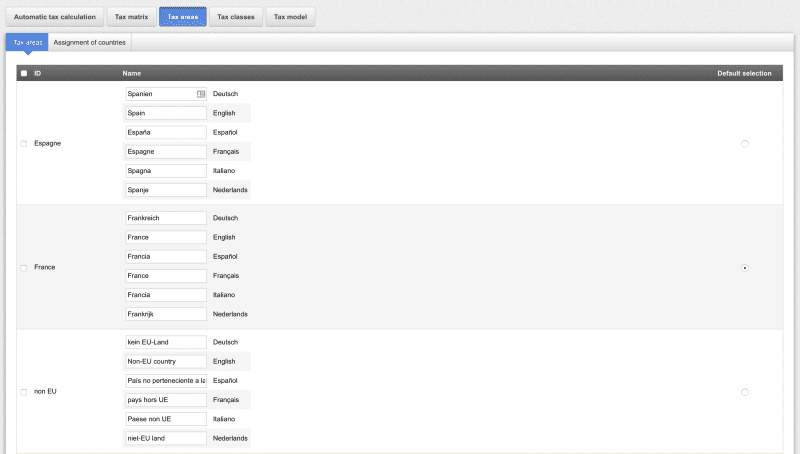EU VAT Reform: Changed delivery thresholds and One-Stop Shop
As of the 1st of July, 2021, a VAT reform for EU-wide online trade will come into force. In this article, you will find out about all the important changes that will affect you as a merchant and how to correctly tax goods in your ePages online shop.
Up until recently, turnover thresholds used to apply for small online businesses that sell only a few products abroad. These were determined by each target country differently. If annual sales were below this respective threshold, the sales tax of the sender country was calculated for sales to end consumers, which made it relatively easy for small businesses with little foreign business. However, the delivery threshold, which was originally up to 100,000 Euros, has recently been lowered further by more and more countries individually, making it more complicated for small businesses if they crossed the respective national borders of the destination countries. The VAT of the respective destination countries then had to be paid in the destination country, which required a tax registration there.
What is new as of 1 July 2021 is that there is a uniform threshold of 10,000 euros net for the sum of all foreign sales within the EU. As long as this threshold is not exceeded, the national VAT of the sender can still be calculated. As soon as the traded amount exceeds the threshold, the VAT rate of the destination country applies. While this may sound stricter at first, the registration and notification are no longer required for each individual destination country, as the procedure is centralised. There is now only one registration procedure for all EU countries. This means that VAT no longer has to be paid separately for individual countries, but only nationally. The tax amounts due are automatically forwarded by the system. This central reporting procedure is called the “One-Stop Shop”.
To which products does the new supply threshold apply?
The new delivery threshold of a uniform €10,000 (net) applies to distance sales of goods, i.e. all cross-border deliveries within the EU to end consumers. This also includes digital services, such as download products. The new regulations also apply to sales made via online marketplaces and product platforms.
What happens if the delivery threshold is exceeded?
If the delivery threshold of €10,000 (net) is exceeded, all cross-border transactions of a year must be processed according to the regulations and tax rates of the recipient destinations. It should be explicitly stated here that this procedure also applies to deliveries to EU countries that have not exceeded the delivery threshold individually – the delivery threshold applies to the aggregated turnover of all EU countries together.
How can I pay my taxes under the new rules?
To avoid complicating the payment of VAT in several countries, your country of residence will provide a so-called One-Stop Shop (OSS) for merchants. Using this system, you can continue to pay all turnover taxes (distance sales, other services to end customers, if applicable via interfaces) centrally in your country of residence without having to register in other EU countries. This procedure is possible immediately as of the 1st of July, 2021.
The procedure in the OSS is as follows:
1. Merchants who are already registered for the Mini One-Stop Shop (MOSS) may not automatically participate in the OSS procedure (see below). This depends on your country of residence. Every EU Member State provides a portal, where you can register. Read more on this here.
2. If you exceed the delivery threshold, the taxes to be paid have to be calculated and paid according to the tax rates applicable in the respective EU countries.
3. The information is checked and the tax amounts due are forwarded.
How can I pay tax on my products if I am below the delivery threshold?
If the delivery threshold is not exceeded, the turnover is taxed as usual and by default at the local national tax rates. Alternatively, if you would like to report your sales via the OSS, please note that the tax rates of the recipient destinations must always be stated via the OSS for sales to other EU countries. Consultation with your tax advisor should be considered for the appropriate procedure in each individual case.
Which procedure do I use if I have used the Mini One-Stop Shop (MOSS) so far?
Some merchants are already familiar with the MOSS procedure, which previously applied to electronically supplied services such as download products but also telecommunications, radio and television services. This procedure could only be used by merchants who have neither a registered office nor a permanent establishment. As of 01.07.2021, the existing MOSS procedure may be integrated into the OSS procedure – means that the MOSS will no longer apply and you will only use the OSS procedure to report and pay your VAT. This depends on your country of residence.
Can I combine OSS and local registrations abroad?
If you are above the supply threshold, accounting via the OSS is not mandatory. It is merely an offer to register your VAT in bundled form. Alternatively, you can still register for tax locally in the respective recipient countries. However, you have to choose either one of these methods. If necessary, ask your tax consultant for advice on a suitable procedure.
How can I correctly tax products in my ePages Now online shop?
This section is aimed at merchants who use ePages Now. A version for ePages Base can be found below. The version of the shop is displayed in the administration area on the Help page at the bottom.
By September 2021, an automatic adjustment of the taxes depending on the EU member state will be available to you in the tax settings of your shop. If your company’s turnover is expected to be above the delivery threshold, select this method in the future to have the current tax rates calculated per EU member state.
Until the change is implemented in your shop, you have the option to enter a manual breakdown by member state into your tax matrix instead of an EU-wide tax jurisdiction to track your sales on a country-by-country basis. Please be aware that you will need to update country-specific adjustments to the local tax rates manually, should there be any.
You can find your tax settings in the administration area under Settings > Taxes. To manually customise the tax matrix, click Customise under the Tax Matrix tab.
1. First, manually itemise your target countries under Tax areas. Rename the default selection “EU country” as the country you want to be your default selection (for example, the Netherlands). Then manually expand your tax areas to include the countries you are shipping to:
2. Under Tax areas > Assignment of countries, assign the newly created area to the appropriate countries:
3. Now you can enter under the tab Tax Matrix which VAT rates (normal/reduced) should be calculated in these countries:
We are constantly updating our software and adding new features. Subscribe to our newsletter to get the latest updates!
How can I correctly tax goods in my ePages Base online shop?
This section is aimed at merchants who use the shop version ePages Base. Guidelines for the shop version for ePages Now can be found above. The version of the shop is displayed in the administration area on the Help page at the bottom.
By September 2021, an automatic adjustment of the taxes depending on the EU member state will be available to you in the tax settings of your shop. If your company’s turnover is expected to be above the delivery threshold, select this method in the future to have the current tax rates calculated per EU member state.
Until the change is implemented in your shop, you have the option to enter a manual breakdown by member state into your tax matrix instead of an EU-wide tax jurisdiction to track your sales on a country-by-country basis. Please be aware that you will need to update country-specific adjustments to the local tax rates manually, should there be any.
You can find your tax settings in the administration area under Settings > Tax Calculation. To manually adjust the tax matrix, click Customise under the Tax Matrix tab.
1. First, manually break down your target countries under the Tax areas tab. To do this, create a new tax area with the country that is to become your default selection (for example, France) and select it as the default in the right-hand column. Delete the tax area “EU”. Now add all other countries to which you are shipping.
2. In the second step, assign the tax areas to the corresponding countries under the tab Assignment of countries:
3. In the tax calculations, select Tax matrix to enter which VAT rates are to be calculated for each country. You can also upload the tax matrix as a CSV file.
We are constantly updating our software and adding new features. Subscribe to our newsletter to get the latest updates!
This article contains initial legal information but does not claim to be complete or correct. It can in no way replace legal advice in individual cases.
Als Content Manager bei ePages ist Sarah für redaktionelle Inhalte und Videocontent zuständig. Im ePages-Blogstellt sie Onlinehändlern Marketingtipps, rechtliche Updates und Infos zur ePages-Software zur Verfügung, um ihnen den Einstieg in den E-Commerce zu erleichtern.








Leave a Reply
Want to join the discussion?Feel free to contribute!